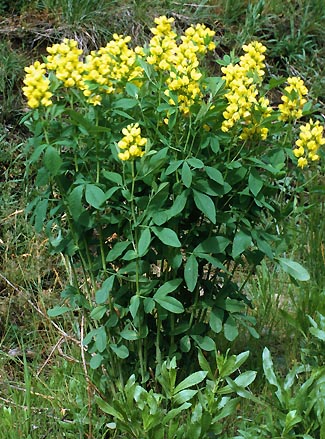Mountain Goldenpea

Common Name(s):
Mountain Goldenpea
Mountain Thermopsis
Mountain Goldenbanner
False Lupine
Scientific Name:
Thermopsis montana Nutt.
Scientific Name Synonyms:
None Known
Symbol:
THMO6
Description:
Life Span: Perennial
Origin: Native
Growth Characteristics: Mountain goldenpea is an erect forb, growing up to 2 feet in height and spreading by rhizomes. It blooms between May and August, depending on the elevations.
Flowers/Inflorescence: Pea-like lemon-yellow colored flowers in a raceme. Flowers are ½ to ¾ inch long. There are five to fifty flowers which make up the inflorescence. The flower spikes arise from the leaf axils
Fruits/Seeds: The seedpods are long, thin, blue/green and covered with downy hairy. They project vertically from the stem. The pods grow quickly in the late spring and early summer, and mature in late summer. There are two to five seeds per pod.
Leaves: Leaves are alternate, palmate, with 3 leaflets, which are oval in shape.
Stems: Multiple stems up to 2 feet tall.
Roots: Rhizomes
Ecological Adaptions:
Mountain goldenpea is found in montane and subalpine zones. It is common in woodlands and meadows.
Soils: Sandy, well-drained soils.
Associated Species: Aspen, lupine, snowberry.
Uses and Management:
Mountain goldenpea is poisonous to cattle. The principle toxin has not been isolated, but is thought to be similar to quinolizidine alkaloids found in Lupines. The toxin causes acute muscle degeneration – cattle become weak, ataxic, and unable to stand. Animals die from hunger and thirst.
Mountain Glodenpea will remain toxic in hay, especially if seed pods are present.

